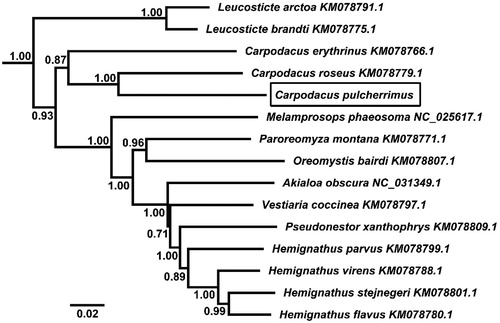Abstract
The Himalayan Beautiful Rosefinch Carpodacus pulcherrimus, belongs to the family Fringillidae, distributed in central Himalayas from India (Himachal Pradesh) to southwest China and Bhutan. The conservation status of this species is least concern (LC) in IUCN. In this study, the complete mitogenome of C. pulcherrimus was determined. The mitogenome is a circular molecule of 16,797 bp in length, containing 13 protein-coding genes, 2 ribosome RNA genes, 22 transfer RNA genes, and 1 non-coding region. We reconstructed a phylogenetic tree based on Bayesian inference for other 14 Fringillidae species. The new mitogenome data would provide useful information for application in conservation genetics and further clarify phylogenetic evolution of this species.
The Himalayan Beautiful Rosefinch Carpodacus pulcherrimus, belongs to the family Fringillidae, distributed in central Himalayas from India to southwest Asia (Dickinson Citation2003). It is found in Bhutan, China, India, Mongolia, Nepal, and Pakistan. The species is associated with the montane and submontane forest edges, scrub, along or above tree-line, also on sparsely vegetated slopes, valleys, and steep hillsides. The species breeds at 3600–4500 m, locally to 4650 m in China. In non-breeding season found in similar habitat at lower altitude (Zhao Citation1995; Zheng Citation2011). Finches (Fringillidae) are mostly colorful, so that species limits have been rarely under debate (Collar and Newton Citation2010). The conservation status of this species is least concern (LC) in IUCN. In China, the species also has been listed as a LC species by the red list of China’s vertebrates (Jiang et al. Citation2016). Up to now, no any complete mitochondrial genome data of C. pulcherrimus is available in the GenBank. In this study, we sequenced the complete mitochondrial genome of C. pulcherrimus (GenBank number: MT648821) examined its phylogenetic position with other Fringillidae species.
The tissue samples were obtained in Chaqing Songduo Nature Reserve, Baiyu County, Sichuan Province, P. R. China (Latitude: 30.984°N, Longitude: 99.342°E, Altitude: 3808 m), and maintained in Sichuan University, Chengdu. The stored number of the sample is CQSD-015. Total genomic DNA was extracted from muscle tissue using the DNA extraction kit (Aidlab Biotech, Beijing, China). The mitochondrial genomes of C. roseus (KM078779.1) is used to design primers for polymerase chain reaction (PCR) and used as template for gene annotation.
The total complete mitogenome sequence of C. pulcherrimus is 16,797 bp, which is composed of 13 protein-coding genes (PCGs), 2 ribosome RNA genes, 22 transfer RNA genes, and 1 non-coding region (D-Loop). The total base composition of the C. pulcherrimus mt genome is an A + T-rich pattern of the vertebrate mitochondrial genomes. ATG is the most common start codon, ATA is used for ND3. C. pulcherrimus had one non-coding region: a 1225 bp control region (D-Loop).
The phylogenetic relationship for the mitochondrial genome sequences newly determined was examined with 15 Fringillidae species. The BI analysis was performed using BEAST version 1.7 (Drummond et al. Citation2012), and the best-fit model (GTR + I+G) of nucleotide evolution was selected using the AIC test in JModelTest 2 (Darriba et al. Citation2012). Phylogenetic tree resulting from the Bayesian inference (BI) analyses showed that C. pulcherrimus was a sister relationship to C. roseus (posterior probability = 1.00) ().
Figure 1. Phylogenetic tree derived from 12 protein-coding gene sequences from 15 complete mitochondrial genomes using BI analysis. Numbers by the nodes indicate Bayesian posterior probabilities.

We first report and analyze the complete mitochondrial genome of C. pulcherrimus. The data will contribute to solve the phylogenetic relations of the genus Carpodacus. And our data would provide reference information for further study of this species and serve as molecular tools to protect it.
Disclosure statement
No potential conflict of interest was reported by the author(s).
Data availability statement
The data that support the findings of this study are openly available in GenBank of NCBI at https://www.ncbi.nlm.nih.gov, reference number MT648821.
Additional information
Funding
References
- Collar NJ, Newton I. 2010. Family Fringillidae (finches). In: del Hoyo J, Elliott A, Christie D, editprs. Handbook of the birds of the world. Vol. 15. Barcelona: Lynx Edicions; p. 440–617.
- Darriba D, Taboada GL, Doallo R, Posada D. 2012. JModelTest 2: more models, new heuristics and parallel computing. Nat Methods. 9(8):772.
- Dickinson EC. 2003. The Howard and Moore complete checklist of birds of the world. 3rd ed. London: Christopher Helm.
- Drummond AJ, Suchard MA, Xie D, Rambaut A. 2012. Bayesian phylogenetics with BEAUti and the BEAST 1.7. Mol Biol Evol. 29(8):1969–1973.
- Jiang ZG, Jiang JP, Wang YZ, et al. 2016. Red list of China’s vertebrates. Biodivers Conserv. 24:5.
- Zhao ZJ. 1995. A handbook of the birds of China. Changchun, China: Jilin Science and Technology Press.
- Zheng GM. 2011. A checklist on the classification and distribution of the birds of China. 2nd ed. Beijing, China: Science Press.
